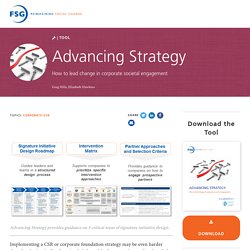

Systems Leadership. The Systems Sanctuary We See You. Systems Thinking Toolkit. Advancing Strategy. Advancing Strategy provides guidance on 3 critical areas of signature initiative design.

Implementing a CSR or corporate foundation strategy may be even harder than developing it. Our learning brief provides best practices and tools to help corporate foundation and CSR leaders advance their strategy. Learn how to overcome common obstacles by applying structured, data-driven processes that transform your corporate societal engagement portfolio. A companion to Simplifying Strategy and developed in partnership with CECP, this brief outlines key design steps that leaders and teams can take to advance their initial strategy choices.
Top Takeaways Our engagement with local stakeholders and partners enhanced our understanding of how the GE Foundation can best collaborate with existing actors and deeply influenced our ultimate program design choices focused on improving patient outcomes. Jennifer Edwards, Director, Developing Health US, GE Foundation. Twitter.
In Alexander's language: - They're ways to structure a system. - Systems compose of sets. - Sets have elements. - Elements interact. Trees are simplistic. Semi-lattices can capture complexity. In trees, there are no interaction between sub-sets. In semi-lattices, all sub-sets can interact with each other. I like Alexander's comparison with social networks - everyone can interact with everyone. Image – barbaragrieve
System Traps. Guidelines for living in a world of systems. Places to Intervene in a System. 3. thinking in systems a primer. Nurse Education in Practice Critical thinking, A two phase framework. What Is Systems Thinking? Habits of a systems thinker.
Many systems thinking concepts are embedded either explicitly or implicitly within the Habits of a Systems Thinker. These include: •Change over time •Accumulations and rates •Interdependencies/circular feedback •Time delays •Unintended consequences •Short/long-term consequences •Leverage •Mental models – barbaragrieve
Enhancing implementation science by applying best principles of systems science. This review is grounded in the ongoing experiences of the authors to devise and implement interventions to promote health equity, including for older adults.

Because the aforementioned interventions are both multilevel and dynamic, the scientific approaches employed evolved from utilising ecological models for thinking through pathways whereby determinants at the societal, community and interpersonal levels affect population and individual health and well-being [1–4], to embracing a portfolio of systems science models that usefully inform related research, practice, policy and education initiatives [5–7]. Forrester, the founder of system dynamics, famously explained that a manager’s verbal description of a corporate organisation constitutes a model [8].
Such mental models of corporations are used by managers to deal with problems that arise on a daily basis. They are not, however, the real corporation. Rather, they substitute in our thinking for the real organisation. Leading in Complex Systems 10 learning points for developing multi agency leadership teams. Making Systems Thinking More Than a Slogan. From climate change and deforestation to collapsing fisheries, species extinction and poisons in our food and water, our society is unsustainable and it is getting worse fast.

Many advocate that overcoming these problems requires the development of systems thinking. We’ve long known that we live on a finite “spaceship Earth” in which “there is no away” and “everything is connected to everything else.” The challenge lies in moving from slogans about systems to meaningful methods to understand complexity, facilitate individual and organizational learning, and catalyze the changes we need to create a sustainable society in which all can thrive.
Here, I’ll describe how the world operates as a system — and how businesses can respond effectively to the challenges we face. Systems thinking is used in the World Economic Forum report (2011) All too often, however, we treat problems in isolation, ignoring the networks of feedback that bind us to one another and to nature. 2) Recognize constraints. Leverage Points: Places to Intervene in a System - The Solutions Journal. In Brief Editor’s note: Donella Meadows’ Leverage Points is a classic reference for those seeking to implement change. As she tells it, Meadows was at a conference on global trade when it occurred to her that the participants were going about everything the wrong way. “These nice, liberal folks” were trying to control growth with adjustments that were “way too puny!” She marched up to a flip chart, tossed over a clean page, and wrote a list that later evolved into the twelve leverage points excerpted here. The list has proven influential to leaders across the globe and, by reprinting it, we hope it will help readers effectively address the world’s most pressing problems.
Key Concepts 12. Solutions Classic How do we change the structure of systems to produce more of what we want and less of that which is undesirable? How Wolves Change Rivers.